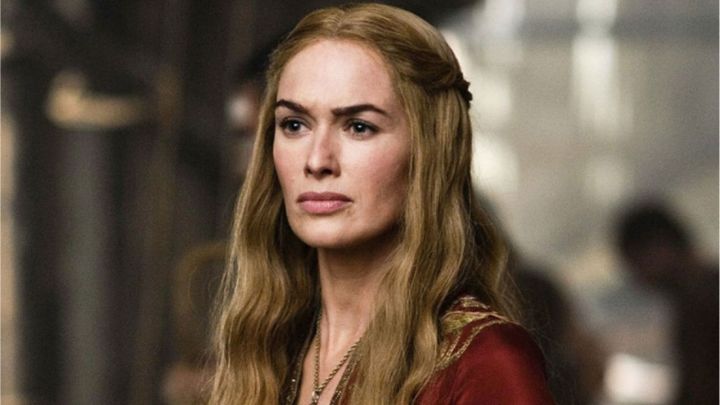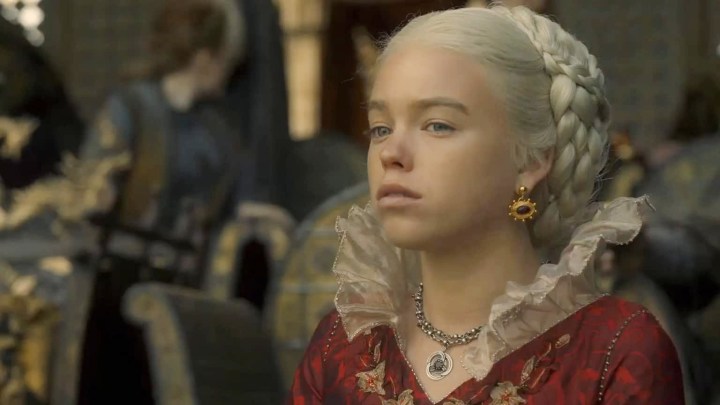HBO’s flashy House of the Dragon is four episodes in, but fans are already hooked on the politics and drama in King’s Landing. Following a disastrous ending to what was arguably the best television show of the new millennium, the world of Ice and Fire had a steep climb uphill to recover the audience’s trust. Game of Thrones broke our collective hearts, so why should we trust this franchise again? Still, George R. R. Martin’s hold on us is more powerful than Valyrian steel because we are back in Westeros and all seems forgotten and forgiven.
It’s easy to see the appeal. House of the Dragon was the last chance to save Game of Thrones‘ stained reputation. If fans were to return to Westeros, they wanted things bigger and bolder than ever; they wanted dragons raging in the sky and fantasy elements to spare, two aspects that the original show didn’t use enough. After disposing of a costly spinoff that would’ve expanded on the White Walker lore, HBO chose to focus on a less risky bet that would make audiences’ return to Westeros more digestible: the Targaryen dynasty. The Dance of the Dragons is one of the flashier chapters in the larger World of Ice and Fire, if not the most complex. It has dragons, exciting battles, and political intrigue aplenty. Above all, it has some of the most compelling female characters in Martin’s world; in fact, the Dance of the Dragons is all about women, for better and worse.
It’s not like Martin’s world has a shortage of female power, as some of Game of Thrones‘ most iconic figures are women. Still, the nature of Westeros and Essos provides these characters with much more agency than many other females in fantasy. Whereas other franchises limit their women to the roles of ethereal goddesses or the standard “strong female character” trope, A Song of Ice and Fire goes deeper into its characters’ psyche. There’s no clear answer about anyone’s nature in Westeros; there’s no “good” or “bad.” The women in the story are messy, brutal, complicated, prone to making mistakes, and allowed to do so. The saga is not perfect by any means — it sends some confusing and ultimately detrimental messages about women in power — but it still allows its leading ladies to be fully fleshed-out characters capable of exploring and displaying their rage.
The Queen’s justice

The “angry woman” trope is particularly problematic. Film and television portray her as prone to overreacting and making a scene; she’s scandalous and impertinent, lacking self-control and decorum. The angry woman contrasts with the story’s classic heroine by violating everyone else’s tranquility. Her anger is treated as either silly and meaningless or scary and invasive; there are no middle lines. The angry woman is hysteria personified.
Think of Medea from Greek mythology, arguably the first-ever angry woman. Comedies like Ferris Bueller’s Day Off, The First Wives Club, and Cruella play their female characters’ anger for laughs. Then there’s the woman scorned, a man’s worst nightmare; think of Foxy Brown in the blaxploitation films of the 1970s and Alex Forrest in Fatal Attraction. The scariest type of angry woman is the one with sufficient power to exact her revenge, like Nancy in The Craft, Hayley in Hard Candy, Amy in Gone Girl, or Carrie from Stephen King’s novel of the same ame. Yet, regardless of tone or genre, an angry woman is a force to be reckoned with; her rage is terrifying. It’s meant to be.
Or so it used to be. Nowadays, stories are changing, allowing the angry woman more depth and complexity. She’s angrier than ever, but her rage is understandable. HBO led the charge in changing the trope on television, with figures like Carmela Soprano, Selina Meyer, and Renata Klein. Characters like Amy Dunne, Betty Draper, and Cassie Thomas flipped the script on female anger, converting it into a tool, not just a weapon. Game of Thrones was at the forefront of redefining the angry woman, thanks to a myriad of layered and defiant ladies who refused to conform to the norms. From Daenerys and Cersei to Catelyn and Brienne, Arya and Sansa, Margaery and Olenna, and Elaria and Shae, in the game of thrones, no woman was quiet. How could they be when everywhere in the world they hurt little girls?
Call me mother

In the world of Ice and Fire, female rage is all about mothers. The story’s most prominent female figures are mothers willing to sacrifice everything and everyone to protect their children. Their actions are questionable, often causing significant problems for the children they’re desperately trying to shield from the world’s cruelties. Other stories take a similar approach, albeit in a more bluntly sentimental way; whereas something like Harry Potter says, “there’s nothing more powerful than a mother’s love,” A Song of Ice and Fire says, “there’s nothing more dangerous than a mother’s rage.”
Cersei Lannister is perhaps the best example of this message. Cruel and shortsighted, Cersei will stop at nothing to protect her children. Her devotion to her offspring is clearer in the show than in the books, but Cersei’s mothering instincts are perhaps her strongest trait. They’re her one redeeming quality; that and her cheekbones. Cersei will burn her house to the ground to protect her children from anyone she deems dangerous, even if they’re not. There’s a possibility that Cersei only loves Joffrey, Myrcella, and Tommen because she considers them an extension of herself, but the fact remains that she will do anything for them. Her vilest acts in the story are in service of guarding or avenging her children. Cersei once famously warned Ned Stark not to underestimate her wrath; he did and paid the ultimate price.
In Westeros, the worst thing anyone can do is anger a mother. Tyrion learns this the hard way when he becomes Catelyn Stark’s prisoner. Cat is the antithesis of Cersei in almost every way; however, their devotion to their children is the one link they share. Jaime Lannister speaks in awe of this love, admiring Cersei and Cat’s pure and intense bond with their offspring. Like Cersei, Cat does several reprehensible things to protect her daughters, mainly freeing Jaime, thus causing disruption and animosity amid Robb’s bannermen. Cat’s initial capture of Tyrion also escalates the tension between the Starks and Lannisters, but she does so anyway to avenge Bran.
Then there’s Daenerys Targaryen, first of her name, Queen of the Andals and the First Men, protector of the Seven Kingdoms, the Khaleesi of the Great Grass Sea, the unburnt, the breaker of chains. Above all else, she is the mother of dragons. Daenerys is the ultimate maternal figure in Game of Thrones. The freed slaves in the free cities of Essos call her mhysa, the High Valyrian word for “mother.” To them, she is more than a liberator or conqueror; she’s a mother, caring and devoted, with a power mighty enough to break their thousand-year-old chains. And that power is, of course, her dragons, hatched in the fires of Khal Drogo’s funeral pyre, born out of Dany’s love and grief. She refers to them as her “children,” mainly because she seemingly lost her ability to birth a human child. And yet, Daenerys is a mother, not just to the dragons, but to everyone. Her subjects see her not as a queen but as a matriarch, their mhysa.
The Queen of Thorns, Olenna Tyrell, is also a fiercely protective maternal figure, not to her buffoonish son, but her grandchildren, Margaery and Loras. Olenna kills Joffrey to save Margaery from a lifetime of torture being married to him and allies with Daenerys to avenge her grandchildren after Cersei blows up the Sept of Baelor. Mothers in Westeros have a devotion that fathers do not share; whereas the former offer honest allegiance and righteous revenge, the latter merely fulfill a role, delivering heirs aplenty to maintain the family name.
The princess and the queen

Beware, spoilers about House of the Dragon ahead: Like its predecessor, House of the Dragon is a story of mothers in rage. It might start as a war of succession, but the conflict escalates when Alicent’s second-born, Aemond, kills Rhaenyra’s second-born, fourteen-year-old Lucerys, in the battle over Shipbreaker’s Bay. Rhaenryra retaliates by sending the infamous assassins Blood and Cheese after Alicent’s grandchildren. The duo infiltrates the Red Keep and kills six-year-old Jahaerys — Alicent’s grandchild and heir apparent to her son, Aegon II — in front of his mother and younger brother, traumatizing them for life. The deaths of their offspring devastate Alicent and Rhaenyra, turning a civil conflict into a war for a dynasty. At its core, the Dance of the Dragons is a story about two enemies bonded by one common sentiment: anger. Fire and blood, indeed.
The Dance has several other key female figures. Rhaenys, the Queen Who Never Was; Mysaria, the Mistress of Whisperers; Alys Rivers, the Witch Queen of Harrenhal; and Nettles, the dragonseed, are among the war’s most interesting and important characters. Even the most passive characters, including the tragic Helaena Targaryen, are layered and dynamic, compelling to the end. Above all, they are angry at their station and their inability to soar in a world designed to make men thrive, and women endure.
More than Game of Thrones, House of the Dragon is a story of the lengths a woman will go to claim what’s hers. It’s a tragedy, but Rhaenyra and Alicent aren’t tragic figures; they are in charge of their actions every step of the way. Their rage comes from a place of systematic injustice and hunger for power. Rhaenyra and Alicent want what they think they deserve and aren’t afraid to kill, torture, maim, and devastate to get it. It is seldom that we get to see female characters so unapologetically amoral; these two women are capable of burning the world down to get their way. Their motives are intriguing, their methods ruthless; it is a George R. R. Martin tale, after all.
In a world as intrinsically amoral as Westeros, war and devastation turn men into monsters. It only makes sense that women would follow suit. And because we expect this cruelty from the story, it’s easier to accept female characters that embrace their rage rather than suppress it. We might even find ourselves rooting for them. Sansa and Arya Stark were ruthless, calculating characters, capable of great brutality. But that was because they had to be to survive in Westeros, and we, as the audience, understood that. The Westerosi woman has to be angry; there’s righteousness in her wrath.
Television has no shortage of antiheroes, but the antiheroine’s rise is only beginning. House of the Dragon thus comes at a crucial time: with Alicent and Rhaenyra leading the charge, the angry woman trope can finally move away from its damaging perception and into a grayer area that welcomes complexity. When done right, the angry woman will no longer be crazy or misunderstood, but capable of exploring her rage without fear or judgment.
And yet, Game of Thrones failed almost all its female characters. It sacrificed Daenerys Targaryen in favor of subverting audiences’ expectations, sidelined Cersei once it didn’t know what to do with her, and reduced Sansa and Arya to walking plot devices. But that doesn’t need to be the fate of House of the Dragon, especially because we know what’s coming. No character, male or female, comes out on top; there’s no redemption for anyone, no light at the end of the road. The Dance of the Dragons is the ultimate tragedy, and HBO needs to own up to that. Make your angry women angrier, HBO, and don’t shy away from their outrage. These are dragons we are talking about; let them be dragons.
House of the Dragon is currently streaming on HBO Max.
Editors' Recommendations
- 5 years ago, Game of Thrones aired its last great episode. Here’s why it still holds up
- The Red Wedding at 10: How the groundbreaking episode changed Game of Thrones forever
- All the new series heading to Max, including Penguin and Harry Potter
- Dungeons & Dragons: Honor Among Thieves reveals what modern fantasy is missing
- Dungeons & Dragons: Honor Among Thieves’ ending, explained




